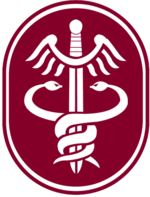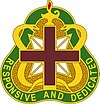| U.S. Army Medical Command | |
|---|---|
 The MEDCOM shoulder sleeve insignia incorporates a modified caduceus with snakes entwining a winged sword, rather than the conventional staff. | |
| Active | 1993 - Present |
| Country | United States |
| Allegiance | United States |
| Branch | United States Army |
| Type | Medical Command |
| Garrison/HQ | Fort Sam Houston, San Antonio, Texas |
| Commanders | |
| Current commander | LTG Patricia Horoho |
| Insignia | |
| Distinctive unit insignia |
 |

The new Army Medicine logo.
The U.S. Army Medical Command (MEDCOM) is a direct reporting unit of the U.S. Army that provides command and control of the Army's fixed-facility medical, dental, and veterinary treatment facilities, providing preventive care, medical research and development and training institutions. MEDCOM is commanded by the Army Surgeon General, currently Lt. Gen. Patricia Horoho. The Surgeon General is also head of the U.S. Army Medical Department (the AMEDD).
Structure and subordinate commands[]
MEDCOM is divided into Regional Medical Commands (RMCs) that oversee day-to-day operations and exercise command and control over the Medical Treatment Facilities (MTFs) in their regions. There are currently five of these regional commands:
- Europe Regional Medical Command
- Southern Regional Medical Command
- Northern Regional Medical Command
- Pacific Regional Medical Command
- Western Regional Medical Command
- Additional subordinate commands of MEDCOM include:
- Army Medical Department Center & School (AMEDDC&S)
- U.S. Army Public Health Command (USAPHC), known as the U.S. Army Center for Health Promotion & Preventive Medicine (USACHPPM) prior to 1 October 2009; it and the U.S. Army Veterinary Command (VETCOM) were merged in 2011 to create USAPHC.
- U.S. Army Medical Research and Materiel Command (USAMRMC)
- Warrior Transition Command (WTC)
- U.S. Army Dental Command (DENCOM)
Operations[]
In garrison (peacetime)[]
MEDCOM maintains day-to-day health care for soldiers, retired soldiers and the families of both. Despite the wide range of responsibilities involved in providing health care in traditional settings, as well as on the battlefield, quality of care compares very favorably with that of civilian health organizations, when measured by civilian standards, according to findings of the DoD's Civilian External Peer Review Program (CEPRP).[1][2] Many Army medical facilities report on their own quality-of-care standards on their individual website.[citation needed]
Deployments[]
When Army field hospitals deploy, most clinical professional and support personnel come from MEDCOM's fixed facilities. In addition to support of combat operations, deployments can be for humanitarian assistance, peacekeeping, and other stability and support operations. Under the Professional Officer Filler System (PROFIS), up to 26 percent of MEDCOM physicians and 43 percent of MEDCOM nurses are sent to field units during a full deployment. To replace PROFIS losses, Reserve units and Individual Mobilization Augmentees (non-unit reservists) are mobilized to work in medical treatment facilities. The department also provides trained medical specialists to the Army's combat medical units, which are assigned directly to combatant commanders.
Many Army Reserve and Army National Guard units deploy in support of the Army Medical Department. The Army depends heavily on its Reserve component for medical support—about 63 percent of the Army's medical forces are in the Reserve component.
History[]
As the post–Cold War Army shrank, the U.S. Army’s Health Services Command (HSC) decided to change the way it did business and operate more like a corporation. In 1992, HSC launched “Gateway To Care”, a businesslike approach to health-care delivery. This was to be localized managed care, with improved quality, access and cost. In a design based more on catchment-area management than the previous “CHAMPUS Reform Initiative” (CRI), U.S. Army hospital commanders received more responsibility and managerial authority. Eleven “Gateway to Care sites opened in the spring of 1992. By that fall, all HSC facilities had submitted business plans which were favorably received. Starting in 1994, “Gateway To Care” was gradually absorbed into a new regional Defense Department tri-service managed-care plan called TRICARE, which was modeled on CRI. In August 1993, the U.S. Army Chief of Staff approved a plan to reorganize the AMEDD. The merger of several medical elements resulted in a new, expanded medical major command under the Surgeon General. In October 1993, the "U.S. Army Medical Command (Provisional)" began a one-year process of replacing HSC and absorbing other AMEDD elements. Surgeon General Lt. Gen. Alcide M. LaNoue commanded the provisional MEDCOM, while Maj. Gen. Richard D. Cameron continued as HSC commander. In November 1993, DENCOM and VETCOM were formed as provisional commands under the MEDCOM, to provide real command chains for more efficient control of dental and veterinary units—the first time those specialties had been commanded by the same authorities who provided their technical guidance. The next month, seven MEDCEN commanders assumed command and control over care in their regions. The new "Health Service Support Areas" (HSSAs), under the MEDCOM, had more responsibility and authority than the old HSC regions. In March 1994, a merger of Medical Research and Development Command, the Medical Material Agency and the Health Facilities Planning Agency resulted in creation of the Medical Research, Development, Acquisition and Logistics Command (MRDALC), subordinate to the provisional MEDCOM. The MRDALC was soon renamed the U.S. Army Medical Research and Materiel Command (USAMRMC). Then, in June 1994, an additional HSSA was formed to supervise medical care in Europe, replacing the 7th Medical Command, which inactivated. That summer, the Army Environmental Hygiene Agency formed the basis of the provisional Center for Health Promotion and Preventive Medicine (CHPPM). Thus, in an unprecedented process of unification, U.S. Army medicine gradually came together in a new home under the command of the Surgeon General. Except for the field medical units commanded by the combat commanders, virtually all of Army medicine is now part of the MEDCOM. The MEDCOM became fully operational, dropping the "provisional," in October 1994. In 1996, the HSSAs were renamed Regional Medical Commands.
See also[]
- Army Medical Department (United States) ("the AMEDD")
- Category:Medical units and formations of the United States Army
- List of former United States Army medical units
References[]
- ↑ Mayer W., et al (1988), “A first report of the Department of Defense external civilian peer review of medical care”; JAMA, 1988 Nov 11;260(18):2690-3.
- ↑ Buck A.S., et al (1992), “The Department of Defense Civilian External Peer Review Program: an interim report”; Mil Med, 1992 Jan;157(1):40-6.
- This article also contains information that originally came from US Government publications and websites and is in the public domain.
External links[]
- Army Medical Department, OTSG, Falls Church VA
- Walter Reed National Military Medical Center, Bethesda, MD
- Tripler Army Medical Center, Honolulu, Hawaii
- San Antonio Military Medical Center, Joint Base San Antonio, TX
- Eisenhower Army Medical Center, Fort Gordon, Georgia
- Landstuhl Army Medical Center, Germany
- Madigan Army Medical Center, Joint Base Lewis-McChord, WA
- Womack Army Medical Center, Ft. Bragg, NC
- Beaumont Army Medical Center, Ft. Bliss, TX
- Army Medical Department, Fort Sam Houston, TX
- Army Dental Command, Fort Sam Houston, TX
- Army Veterinary Command, Fort Sam Houston, TX
| |||||||||||||||||||||||||||||||||||||||||||||||||||||||||||||||||||||||||||||||||||||||||||
The original article can be found at United States Army Medical Command and the edit history here.
